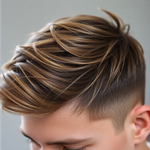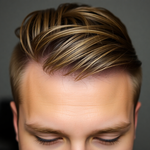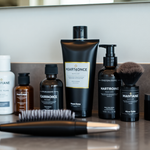
Palette Playbook: Matching Semi-Permanent Hair Color Tones to Your Sustainable Men's Wardrobe
16 August 2025
Share
Palette Playbook: Matching Semi-Permanent Hair Color Tones to Your Sustainable Men's Wardrobe
Struggling to make your hair and closet work together without wasting time or cash? Palette Playbook: Matching Semi-Permanent Hair Color Tones to Your Sustainable Men's Wardrobe shows you how to align semi-permanent hair color with a sustainable men's wardrobe so your whole look reads intentional, not thrown-together. In this long-form guide you’ll get science-backed tips, practical steps, and low-waste maintenance routines you can use right away.
Why this alignment matters (and why men care)
Look: clothes and hair are a visual system. When they speak the same language—tone, temperature, texture—you look sharper and save wardrobe decisions later. That matters whether youre a grad student, a young pro, or a dad juggling work and weekend life. Matching hair tones to a sustainable wardrobe increases outfit versatility, reduces impulse purchases, and reinforces the low-waste mindset behind sustainable menswear.
Quick definitions: semi-permanent color and sustainable men's wardrobe
- Semi-permanent hair color: A dye that deposits color on the hair shaft without fully penetrating the cortex. It fades over weeks to months and is generally less damaging than permanent dyes.
- Sustainable men's wardrobe: A closet built around durable, ethically-made pieces (organic cotton, recycled polyester, low-impact dyes, and repairable items) that prioritize longevity over trends.
How color theory works for real-life wardrobes
Color tone is about temperature (warm vs. cool), value (light vs. dark), and saturation (muted vs. vivid). Your hair tone should either harmonize with or intentionally contrast your wardrobe. Harmonizing is easiest for capsule wardrobes; controlled contrast works for statement pieces.
- Warm tones (gold, caramel, auburn): Pair with earth tones—olive, rust, tan, warm denim.
- Cool tones (ash, steel, cool brown): Pair with monochrome palettes—greys, navy, black—or jewel tones like sapphire and emerald.
- Neutral tones (medium brown): Universally flattering and low-maintenance—great for minimalist capsules.
Palette Playbook: Matching Semi-Permanent Hair Color Tones to Your Sustainable Men's Wardrobe (Step-by-step)
Follow these steps to choose a semi-permanent tone that complements what you already own.
-
Wardrobe audit (10–15 minutes):
- Pull 12 of your most-worn pieces: jackets, tees, sweaters, jeans.
- Note dominant colors and their frequencies (e.g., five items are navy, three are olive, two are grey).
- Assess textures: natural fibers (wool, cotton) vs. synthetics (recycled polyester).
- Identify the dominant temperature: Warm, cool, or neutral. If youre evenly split, default to neutral or choose based on head-turning pieces (jackets, shirts you wear to events).
- Pick two tones: A primary, everyday tone; and an accent tone for subtle lowlights/highlights or a weekend look. Keep accents within one or two levels of the primary to remain natural.
- Do a strand test: Use a semi-permanent swatch or color-depositing product on a hidden strand. Wear it for a week through your normal routine to evaluate fade and compatibility.
- Evaluate in situ: Take photos in natural light wearing three go-to outfits. Check how skin tone, eye color, and clothes interact with the hair tone.
- Commit sustainably: Choose vegan, cruelty-free semi-permanent formulas and color-depositing maintenance products to avoid frequent re-dyes.
Choosing tones based on wardrobe archetypes
Not all sustainable wardrobes are the same. Below are common archetypes and the semi-permanent choices that work best for each.
-
The Minimalist Capsule (black, grey, white, navy):
- Best hair tones: cool espresso, ash brown, deep neutral brown.
- Why: maintains clean contrast and prevents the look from appearing dated when hair leans too warm.
-
The Earthy Utility Wardrobe (olive, tan, rust, denim):
- Best hair tones: warm chestnut, light mocha, subtle caramel gloss.
- Why: adds warmth that echoes natural fibers and rugged textures.
-
The Casual Denim Core (indigo, faded denim, white tees):
- Best hair tones: neutral-to-cool browns, soft blondes for lighter skin tones.
- Why: denim pairs well with understated natural hair tones—keeps the focus on fit and proportion.
-
The Color-Forward Wardrobe (jewel tones, seasonal accents):
- Best hair tones: neutral dark brown or warm deep brown with subtle lowlights.
- Why: a neutral hair base supports bold garments without competing for attention.
Semi-permanent chemistry: what to consider
Semi-permanent dyes work by coating the hair shaft and depositing pigments without using strong oxidizers. That means less damage, but also less lift—so if youre going significantly lighter, semi-permanent may only work on pre-lightened hair. For glossing, toning, or going darker, its ideal.
Key things to check on product labels:
- Sulfate-free and low-alcohol formulas to reduce drying.
- Vegan and cruelty-free certifications if sustainability matters to you.
- Packaging: refill options, recyclable tubes, or minimal plastic.
How to perform a strand test (detailed)
- Choose a hidden area (behind the ear or under the crown).
- Use the exact amount and mixing ratio the product specifies.
- Apply to an inch-long band of hair and process for the recommended time.
- Rinse and shampoo with a color-safe product; wear the strand for a week and photograph on day 1, 4, and 7.
- Check for fade, unexpected undertones, and how the color sits against your clothes.
Maintenance: low-waste routines that preserve color
Keeping color vibrant doesnt require daily washing or constant re-dyes. The trick is strategic care.
- Wash less: Aim for 23 times per week. Use dry shampoo between washes to control oil without water waste.
- Cold or lukewarm rinse: reduces color bleed and saves energy.
- Color-depositing products: Use a pigmented conditioner or no-rinse leave-in once every 12 weeks to top up color instead of a full dye session.
- Heat minimalism: Limit styling heat; when you use it, use a heat protectant to prevent drying and faster fade.
- Refillable care: Choose shampoos and conditioners sold in refill pouches or recyclable containers.
Styling and grooming to enhance the match
Hair color pairs with cut and texture. A good cut frames the face and helps the tone read as intentional rather than accidental.
- Textured crop or fade: suits most tones and keeps upkeep quick.
- Longer, brushed-back styles: show off balayage or lowlights; these styles pair well with natural-looking color transitions.
- Facial hair: match undertones subtly. Warm hair tones pair with warmer beard shades and vice versa.
Real-world scenarios and anecdotes
Picture this: Youre heading to a first date and want to look put-together but not overdone. You picked a warm chestnut semi-permanent gloss to match your olive jacket and tan knit. The result: your skin looks warmer, the jacket reads richer, and you dont need another shirt to feel "date-ready." Thats the kind of small, sustainable tweak that pays off.
Another example: A young professional swaps from a golden brown to a cool espresso before moving into a grey-and-navy capsule—suddenly his jackets and shirts look crisper; he gets fewer wardrobe mismatches and fewer impulse buys.
Image guidance: photographs and alt text
When you publish or post, use clear visuals that show the relationship between hair and outfit. Suggested image types:
- A three-panel comparison: wardrobe swatches, hair swatch, and a styled outfit photo.
- Before-and-after strand test photos shot in the same natural light.
Example alt text: "Man wearing Menll.com EcoSneak shoes and recycled wool jacket with warm chestnut hair in urban setting."
Sourcing sustainably: how to pick eco-friendly semi-permanent products
- Check ingredient transparency: brands that publish full ingredient lists and sourcing info are preferable.
- Look for lower-impact certifications: cruelty-free logos, Vegan Society, and third-party sustainability claims.
- Minimize single-use waste: choose concentrates, bars, or refill systems over single-use sachets when possible.
Budget moves: getting the look without overspending
- Start with a strand test, not a full kit—many brands sell single-use swatches.
- Buy multipurpose products: color-depositing conditioners do double duty as hydrate + refresh color.
- Work color into your grooming schedule: refresh during monthly grooming appointments instead of weekly at-home treatments.
Color trouble-shooting: common issues and fixes
- Too warm: Use a clarifying wash followed by a cool-toned color-depositing product; avoid bleaching at home.
- Too ashy or flat: Add warm-toned leave-in glosses in small doses to restore life.
- Uneven fade: Use a pigmented mask to even things out and plan more gradual color shifts next time.
How to integrate Menll.com pieces
Menll.coms sustainable offerings—like the EcoSneak Casual Shoes and the recycled-wool field jacket—work particularly well with neutral hair tones that optimize outfit cohesion. Swap in a warm chestnut gloss if your closet has lots of olive and tan, or pick a cool espresso if your capsule is monochrome. Explore a curated outerwear set here: Menll.com Outerwear. These pieces are designed to be durable, repairable, and versatile—perfect for the palette-first approach.
Sources and safety reminder
Always patch-test before using any dye product. For more on safety and allergy testing, see this overview from WebMD: WebMD: Hair Dye Safety. If you have scalp conditions or severe allergies, consult a dermatologist before coloring.
Bringing it together: a 30-day challenge
Try this 30-day challenge to lock in your new palette-smarts:
- Week 1: Wardrobe audit + strand test of two tones.
- Week 2: Apply preferred semi-permanent tone; take outfit photos with three core outfits.
- Week 3: Maintain with color-depositing conditioner once, and practice low-wash habits.
- Week 4: Review photos, tweak tone if necessary, and plan next maintenance step (deposit refresh or trim).
Final checklist before you dye
- Wardrobe audit completed and dominant temperature identified.
- Strand test performed and evaluated in natural light.
- Selected a sustainable, low-impact semi-permanent product and maintenance plan.
- Prepared a low-waste maintenance kit (color-depositing conditioner, sulfate-free shampoo, refillable containers).
Conclusion: small changes, big returns
Palette Playbook: Matching Semi-Permanent Hair Color Tones to Your Sustainable Men's Wardrobe is not about chasing trends. Its about practical alignment: selecting semi-permanent hair color that extends the life and versatility of the clothes you already own. Make one small changea strand test, a toned gloss, or a single color-depositing maskand youll be surprised how much sharper and more cohesive your look becomes.
Which wardrobe tone are you matching first? Drop a comment below and tell us which outfit youll test it with, or browse Menll.com to find a few sustainable staples that pair with your new hair palette.
Vorheriger Beitrag

Color Confidence: How Semi-Permanent Hair Dye Streamlines a Sustainable Men's Capsule Wardrobe
Aktualisiert am 17 August 2025
Nächster Beitrag
Semi-Permanent Hair Color for Men: Match Shades to a Sustainable Capsule Wardrobe
Aktualisiert am 15 August 2025





